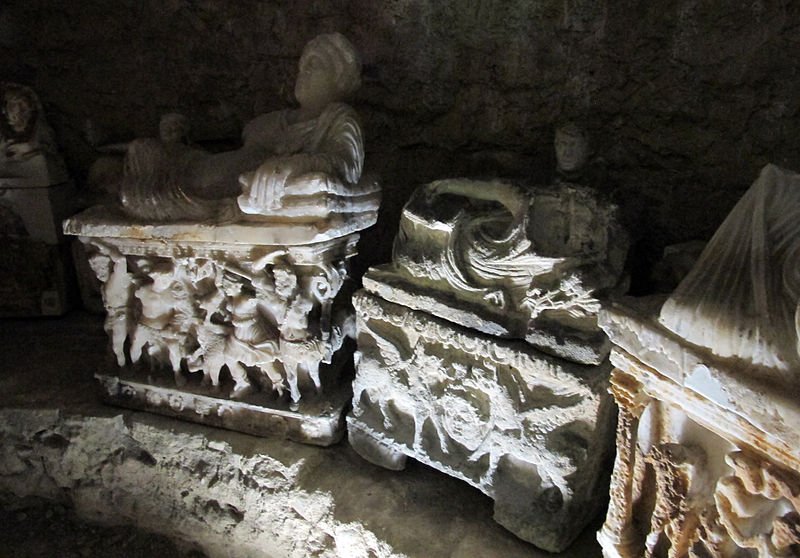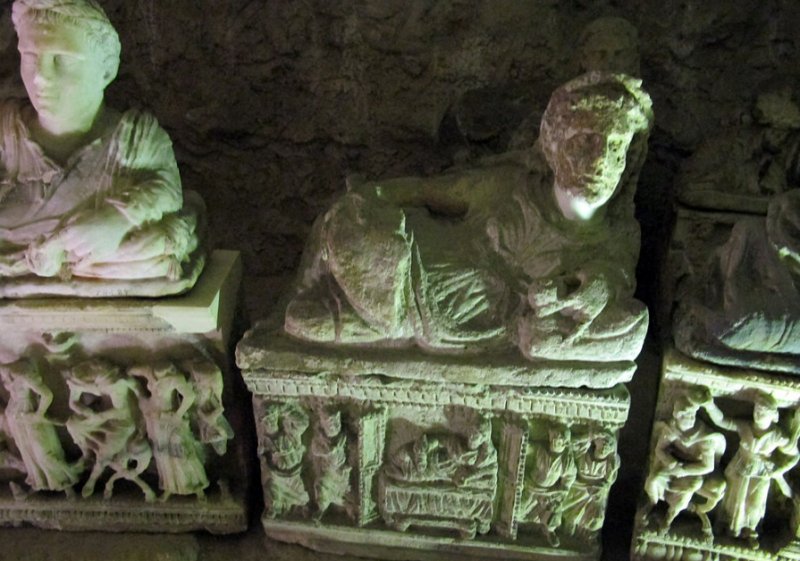Inghirami Tomb – Spectacular Etruscan Burial With 53 Alabaster Urns In Ancient City Of Volterra, Italy
A. Sutherland - AncientPages.com - Many secrets of the ancient Etruscans, who represent one of the most enigmatic civilizations in Europe, are still to be discovered.
Etruscan cemeteries contain different burial practices dated from the 9th to the 1st century BC and bear witness to the achievements of Etruscan culture, which, over nine centuries, developed the earliest urban civilization in the northern Mediterranean.
Inghirami Tomb in ancient Ccity of Volterra, Italy. Image credit: Sailko - CC BY-SA 3.0
Some tombs are monumental, cut in the rock, and decorated by impressive tumuli (burial mounds) and carvings. In contrast, others have wall paintings that successfully survived until now. However, many Etruscan tombs have been looted over the centuries.
Among those still preserved is the Inghirami Tomb, which belonged to the Atia family and is one of the most impressive tombs from the Etruscans' Ulimeto necropolis.
It contained fifty-three urns dating from the first half of the second to the middle of the first century.
The 'Inghirami Tomb' is considered one of the best-known late Etruscan tomb complexes. Two Inghirami brothers discovered it and visited the Ulimeto necropolis outside Volterra, Italy, in 1861.
Etruscan City Of Volterra
A ring of defensive walls surrounds Volterra, an ancient fortress city with Etruscan roots, built by the Medici family in 1474 on the remains of older fortresses. The construction appeared two years after the city of Florence had conquered Volterra after a brutal war over the control of the alum mines.
Closed within mighty old walls and situated on a hill 545 meters above sea level, Volterra is far from the sea and the urban settlements. Over the centuries, it was the city's most favorable strategic position. However, the massive fortress ("Fortezza dei Medici") was not built to protect the area but to subjugate the whole community and discourage rebellion.
However, although the city was closed within its walls, it was repeatedly captured but maintained some independence until the Romans finally conquered it.
Thanks to rich history and culture, Volterra could preserve several monuments, including the 'Inghirami Tomb.' The two young brothers accidentally found the structure outside Volterra's wall circle, where they went to spend their holiday.
Beneath a grassy mound, the boys discovered a subterranean structure - a tomb constructed of a circular chamber roughly hewn in the bedrock, without any decorations, and enclosed by a false dome supported by a central pillar. An entrance passage leads to the room, cut into the tufa rock.
Inside the tomb's chamber are fifty-three spectacular, beautiful cinerary alabaster urns and round central pillars supporting the ceiling, all made from local alabaster stone. The tomb chamber was filled with sixty chests from five-six generations, placed in two rows on the bench and in front of the central pillar.
Inghirami Tomb - Volterra, Italy. Image credit: Sailko - CC BY-SA 3.0
Traditionally, the primary function of the urns was to hold a person's ashes after cremation. This funeral tradition was popular among both classical and prehistoric cultures. The structure represents a characteristic Volterran tomb dated to the 4th-1st century BC. Relief decorations and the reclining lid figures representing the deceased create an illusion of a banquet hall. However, these sculptural decorations were not intended to be public manifestations.
The Inghirami Tomb allows us to admire something from the distant past because there are not many valuable places to see. Almost all the Etruscan tombs were looted in antiquity a long time ago.
The Etruscan urns lack Latin inscriptions typically found on the ones dated to Roman times. Today, the jars that belonged to an Etruscan Volterranian family Ati (Atia), are stored in Florence, Italy. ¨
After the reconstruction, the tomb is now in the garden of the National Archaeological Museum of Florence.
Written by – A. Sutherland - AncientPages.com Senior Staff Writer
Updated on March 07, 2023
Copyright © AncientPages.com All rights reserved. This material may not be published, broadcast, rewritten or redistributed in whole or part without the express written permission of AncientPages.com
Expand for referencesReferences:
MacIntosh Turfa J, The Etruscan World
National Archaeological Museum of Florence
Haynes Sybille, Etruscan Civilization: A Cultural History
Banti, Etruscan Cities and Their Culture
More From Ancient Pages
-
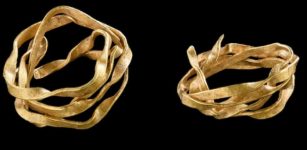 Gold Spiral In Early Bronze Age Grave – Unearthed
Archaeology | Jun 1, 2021
Gold Spiral In Early Bronze Age Grave – Unearthed
Archaeology | Jun 1, 2021 -
 Unexpected Archeogenetic Study Results Obtained In Graves Of Mödling And Leobersdorf, Lower Austria
DNA | Jan 16, 2025
Unexpected Archeogenetic Study Results Obtained In Graves Of Mödling And Leobersdorf, Lower Austria
DNA | Jan 16, 2025 -
 Legendary Grianán Of Aileach Built By God Dagda Of Tuatha De Danann Was Once The Royal Seat Of The Kingdom Of Ailech
Featured Stories | May 13, 2021
Legendary Grianán Of Aileach Built By God Dagda Of Tuatha De Danann Was Once The Royal Seat Of The Kingdom Of Ailech
Featured Stories | May 13, 2021 -
 Fortified Bronze Age City Filled With Magnificent Ancient Treasures Solves A Mystery In China
Archaeology | Nov 21, 2023
Fortified Bronze Age City Filled With Magnificent Ancient Treasures Solves A Mystery In China
Archaeology | Nov 21, 2023 -
 Roman Empire’s Emerald Mines In The Egyptian Eastern Desert – New Evidence
Archaeology | Mar 2, 2022
Roman Empire’s Emerald Mines In The Egyptian Eastern Desert – New Evidence
Archaeology | Mar 2, 2022 -
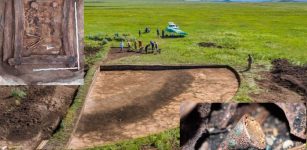 Ancient Burial Of Woman Equipped With A Unique Gold Pectoral Ornament Discovered In Siberian ‘Valley Of The Kings’
Archaeology | Feb 15, 2022
Ancient Burial Of Woman Equipped With A Unique Gold Pectoral Ornament Discovered In Siberian ‘Valley Of The Kings’
Archaeology | Feb 15, 2022 -
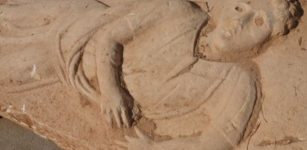 Unique 1,800-Year-Old Stone Sarcophagus Exposed In Ashkelon Building Site
Civilizations | Sep 6, 2015
Unique 1,800-Year-Old Stone Sarcophagus Exposed In Ashkelon Building Site
Civilizations | Sep 6, 2015 -
 How Did St. Nicholas Become Santa Claus? – History, Legend And Tradition
Featured Stories | Dec 22, 2023
How Did St. Nicholas Become Santa Claus? – History, Legend And Tradition
Featured Stories | Dec 22, 2023 -
 Remains Of An Ancient Seaport In Asini, Greece Discovered By Underwater Archaeologists
Archaeology | Mar 12, 2025
Remains Of An Ancient Seaport In Asini, Greece Discovered By Underwater Archaeologists
Archaeology | Mar 12, 2025 -
 DNA Study Reveals How Europe’s Hunter-Gatherers Adapted To A New Way Of Life – Farming
Archaeology | Nov 24, 2015
DNA Study Reveals How Europe’s Hunter-Gatherers Adapted To A New Way Of Life – Farming
Archaeology | Nov 24, 2015 -
 Thor: Brave And Mighty Thunder God In Norse Mythology
Featured Stories | Nov 7, 2016
Thor: Brave And Mighty Thunder God In Norse Mythology
Featured Stories | Nov 7, 2016 -
 Tests On Tutankhamun’s Tomb: Non-Invasive Radar Search For Nefertiti To Start Thursday
Archaeology | Nov 23, 2015
Tests On Tutankhamun’s Tomb: Non-Invasive Radar Search For Nefertiti To Start Thursday
Archaeology | Nov 23, 2015 -
 Drinking Milk Increased Ancient Human Body Size – New Study
Archaeology | Jan 18, 2023
Drinking Milk Increased Ancient Human Body Size – New Study
Archaeology | Jan 18, 2023 -
 Elusive Non-Binary Gender In Prehistoric Europe – A Forgotten Minority
Archaeology | May 26, 2023
Elusive Non-Binary Gender In Prehistoric Europe – A Forgotten Minority
Archaeology | May 26, 2023 -
 Prehistoric Spread Of Millet From East Asia To Central Europe – New Study
Archaeology | Jun 10, 2022
Prehistoric Spread Of Millet From East Asia To Central Europe – New Study
Archaeology | Jun 10, 2022 -
 On This Day In History: Samuel F.B. Morse Receives A Patent For His Dot-Dash Telegraphy Signals – On June 20, 1840
News | Jun 20, 2016
On This Day In History: Samuel F.B. Morse Receives A Patent For His Dot-Dash Telegraphy Signals – On June 20, 1840
News | Jun 20, 2016 -
 Bes: Egypt’s Intriguing Dwarf God Of Music, Warfare And Protector Against Snakes, Misfortune And Evil Spirits
Egyptian Mythology | Jul 31, 2016
Bes: Egypt’s Intriguing Dwarf God Of Music, Warfare And Protector Against Snakes, Misfortune And Evil Spirits
Egyptian Mythology | Jul 31, 2016 -
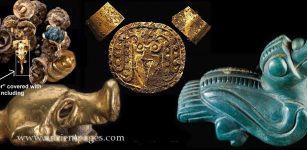 Mysterious Golden Lords Of Panama
Artifacts | Aug 23, 2018
Mysterious Golden Lords Of Panama
Artifacts | Aug 23, 2018 -
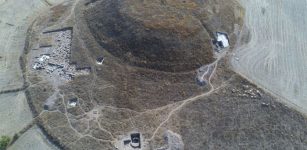 Mysterious Ancient Circular Structure Discovered In Turkey – Has Zippalanda, The Lost City Of The Hittites Been Found?
Archaeology | Dec 27, 2022
Mysterious Ancient Circular Structure Discovered In Turkey – Has Zippalanda, The Lost City Of The Hittites Been Found?
Archaeology | Dec 27, 2022 -
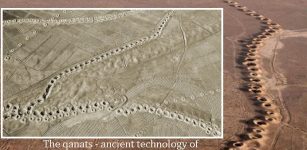 Qanats: Ancient 3,000-Year-Old Underground Irrigation Canals Invented By People Of Persia
Ancient Technology | Jul 13, 2020
Qanats: Ancient 3,000-Year-Old Underground Irrigation Canals Invented By People Of Persia
Ancient Technology | Jul 13, 2020


